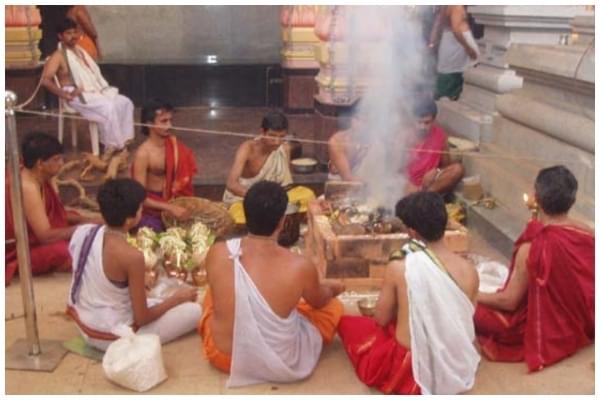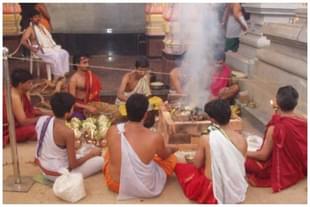Commentary
Prana Pratishtha And Acharyas: In Dharmic Traditions, Diversity Doesn't Undermine Unity
Vijay Satnarine
Jan 21, 2024, 04:46 PM | Updated 04:46 PM IST
Save & read from anywhere!
Bookmark stories for easy access on any device or the Swarajya app.


The Shri Ram Janmabhoomi Mandir prana pratishtha is finally underway, and Hindus across the globe are immersed in a devotional wave of the name and pastimes of Shri Ram like none before.
It is not only a celebration of the spiritual gifts of our Dharmas and the sacrifices of our foreparents, but it marks a historic point: Ayodhya is one of the seven holiest places (mokshadayini sapta-puri) of all of our Hindu Dharmas. The incontrovertible evidence – that for centuries the Janmasthanam site was occupied for spiritual purposes by peoples of the Dharmas before the former masjid was constructed on the site – finally enabled the Supreme Court to rule on the basis of evidence, and not on the popularity contests of historians, politicians, or global commentators thereby influenced.
We finally have unrestricted access to one of our seven Hindu holy places: Ayodhya’s Shri Ram Janmasthanam after more than five centuries.
But media and politics swooped in to try and find further ways of sustaining themselves, latching on to the viewpoints of two leading Hindu spiritual leaders, Jagadguru Shankaracharya Swami Nishcalananda Sarasvati Ji Maharaj and Jagadguru Shankaracharya Swami Avimukteshvarananda Sarasvati Ji Maharaj, two of the four (or five) most important Shankaracharya of our Dharma, to back up their claims that the pratishtha is not happening in accordance with the scriptures.
As much as we pride ourselves on our knowledge of scriptures, sadly, us Hindus lack wisdom when it comes to our Dharmas.
From Hindu journalists calling Bhagavan Ram's murti an “idol” (a term that actually means a condemnable item other than God that is being worshipped), to an absolute lack of awareness on who can provide guidance on matters of Dharma – the prana pratishtha coverage has been yet another case when Hindus confirmed that we have yet to understand the corner the West and internally westernized Indians have pushed us into and how to intelligently navigate out of it.
Only a few speakers in the Indian media have done justice to this event. Predictably, those weren’t the ones that foreign media relied upon for their complete politicization of this cherished historical and spiritual event. Yes, foreign media will do what it pleases. But, we do not need to be adding fuel to the fire – especially if it is due to our own ignorance.
When Shankaracharya himself was alive, there were numerous, different schools of thought in existence. The Agamadambara of the 10th century Kashmiri nyaya luminary Jayantabhatta testifies to the fact that our Dharmas held councils to which all Jagadguru-level Acharyas were invited to state their viewpoints.
The crucial takeaway from his works is that Hindus are supposed to know of, and be comfortable with differences of opinion without undermining efforts that benefit humankind.
Sure, two Jagadguru Shankaracharyas have a specific point of view, but the other two (or three) do not share that point of view.
Moreover, Smarta Dharma is just one of the Dharmas that are Hindu: Vaishnava, Shaiva and Shakta Dharmas all have their paramparas alive and intact, and their Jagadgurus or Acharyas are more than competent at providing guidance from within their traditions.
Hindu Dharma has never had one, papal-like authority, let alone a supreme leader or pontiff. Hindu commentators could have easily diffused the claims of “controversy” simply by being able to comprehend that, in Dharmic traditions, diversity does not undermine unity.
Our Dharmas have different perspectives on festival dates, codes of conduct, spiritual methodology, etc. which our ancients saw as a beautiful thing –
trayi saaṅkhyam yogah pashupatimatam vaishnavam iti,
prabhinne prasthaane param idam adah pathyam iti cha |
ruchinaam vaichitryad rju-kutila-naanaa-patha-jushaam,
nrnaam eko gamyas tvam asi payasaam arnava iva || Shri Shivamahimnaḥ Stotram 7 ||
Translation: The Vedic (Smarta), Sankhya, Yoga, Pashupata (Shaiva), Vaishnava, and all other Dharma pathways teach of the highest goal and methods to achieve it in different ways. Humans take these direct or meandering paths in accordance with their various likes and propensities (ruchi) – yet all of them lead to You! You are like the ocean into which flow waters from all types of sources.
This verse does not mean that diversity is immaterial, that we should think and act in one way, and that if we don’t do so, we are wrong. It means that all our reasonable approaches are justified: all logical paths are valid.
Multiple valid paths is the heart of our Hindu civilisation, not the enforcement of one over the other. Bhagavan Ram himself set the example, seeking the accompaniment through friendship of numerous types of peoples and living beings for the singular purpose of the retrieval of Bhagavati Sita. Did they all think and live in the same way? Absolutely not. Was the goal reached? Of course.
We must be able to reclaim our own ancestral ability to hold multiple viewpoints with respect, and start living life in accordance with it.
How would this have affected the prana pratishtha?
Granted, the first, initial prana pratishtha of Shri Ramlalla is taking place – and it is in compliance with the Shastra teachings that are followed by the Yajnacharyas and Sadhus advising this initial phase. They did their absolute best to invite everyone so that there is representation from all walks of life.
However, representation as the method of inclusion of diversity is a western idea that is domiciled in Indian politics. Even the U.S. is only recently learning the pitfalls of this method.
The final, grand prana pratishtha of the Shri Sita-Rama Parikara is yet to come, which will take place upon the completion of the entire Mandir.
There is an easy, more traditional way to ensure that on that occasion we can avoid an onslaught of smear campaigns by adopting a simple method of managing our varieties of Dharma: the homegrown, indigenous Dharmic method of living respectfully, thoughtfully, and lovingly with diversity.
I humbly submit just one idea for how to do so, in the spirit of the great Acharya Jayantabhatta.
Using the time between now and the proposed final completion date, the Shri Ram Janmabhoomi Trust could send delegations to speak to each of the Jagadgurus or Acharyas of the Ancient Dharma traditions of Smartas, Vaishnavas, Shaivas, and Shaktas.
Additionally, delegations should visit the heads of the sampradāyas established after the Middle Ages, and, importantly, to the heads of Ancient Dharma traditions that are beyond the Vedas, such as the practitioners of Sarna, Kiraat, Sanamaha, and other ancestral Dharmas.
Given the importance of Shri Ram Janmasthanam to the Sikh, Jain, and Buddhist Dharma traditions and the similarities of Vedic rituals with those of Zarathustra’s Dharma, their interested leaders should also be connected to the broader effort by the Trust.
The Uttar Pradesh Government is adept at facilitating the Kumbha Mela, so even with its logistical challenges, it should not be an insurmountable task to provide logistical support for all the Jagadgurus and Acharyas that would like to participate on the basis of that initial outreach.
Shri Ram Janmabhoomi Trust, in consultation with the concerned federal and state agencies, would then find open spaces for the ceremony grounds and for tent-residences. Each of the Jagadgurus or sampradaya Acharyas could be given equal space for a ceremonial shaala - whether yajna, dhyana, yoga, or other traditional practice – and space for them and 11 of their vidvans and attendants to put up a temporary residence in the residential area.
Would it not be an amazing sight to behold all the Jagadgurus and Acharyas performing ceremonies or spiritual practices in accordance with their own Dharmas, all for the glorification of Shri Ram Janmabhoomi?
Shri Ramlalla could visit each of the shaalas throughout the week of ceremonies, and each sampradaya be given the opportunity to interact personally with Bhagavan Shri Ram in a method of their choice, agreed with the Trust.
Finally, for the maha-nyasa and prana-pratishtha of the new Murtis of the Shri Ram Parikara, they could select the revered Sadhus who gave evidence in the courts to do the actual avahana of the Murtis, or the Vaishnavas and Smartas (the Dharma traditions that have enduring histories of Rama devotion) select a Jagadguru to do the invocation for each Murti, and have all the remaining Acharyas and Jagadgurus perform the abhishekam of the shikhara kalasha/kumbhabhishekam.
Yajamanas (ceremonial sponsors) are always invited to participate in the performance of pujas. Yet, for the prana-pratishtha of such important deities in the sacred city of Ayodhya, it would be a beautiful thing for the learned, spiritually awakened spiritual leaders of our Dharmas to do the actual spiritual work of avahana.
Once that is done, it would be a delight to see the yajamanas and the leaders of our nation gather to perform the first Aarti and open the darshana lines to welcome the very first darshanarthis to the completed Mandir after more than five centuries.
An assembly thereafter would welcome the attendance of the leaders of all religions and nations that are interested in participating, and together with devotees from all over, the grand opening ceremonies would be concluded in devotion.
Would it not be an amazing sight to behold the synergy of our Dharmas generating the ancient spiritual energies in accordance with the Dharmic worldview of unity and diversity?
Though this is just one suggestion, the overall intention is to highlight that the best way for Dharma practitioners is the Dharmic way. Let us abandon our residual colonial approaches, and live our modern lives with the ever-relevant inspiration of Shri Ram!
||Jaya Shri Sita Ram||
Vijay Satnarine is the Director Education Strategy at the Hindu American Foundation. He has a Ph.D. in Sanskrit and is a traditionally trained Yajnacharya. Views expressed here are his own.





